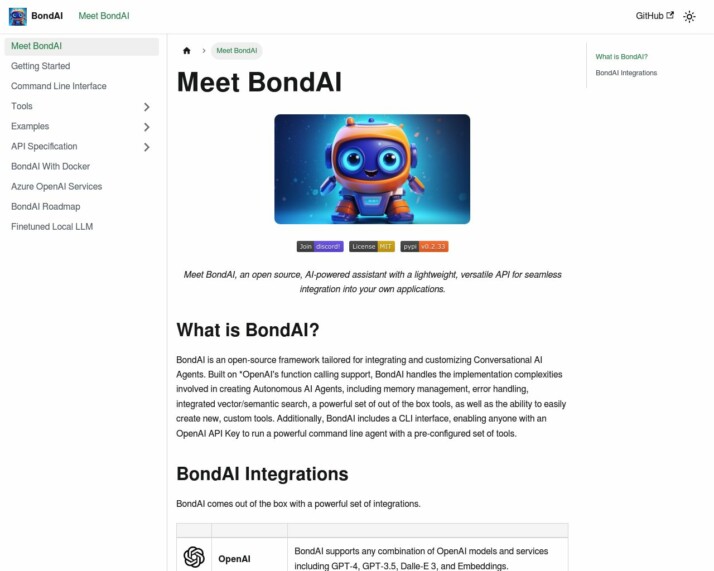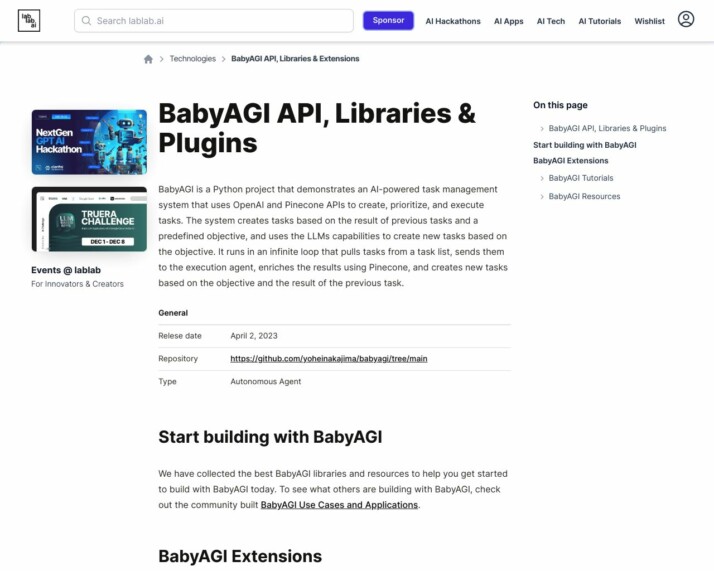Table of Contents
Introduction
Are you looking to integrate and customize Conversational AI Agents? If you’re interested in comparing BondAI and BabyAGI, you’re in the right place.
BondAI caters to a range of users, including developers, businesses, innovators in Conversational AI, and tech-enabled service providers.
It offers a flexible framework, comprehensive API, and a variety of tools to create custom AI-driven applications. On the other hand, BabyAGI is an autonomous agent that generates and executes tasks based on given objectives, showcasing its autonomous functioning.
In this article, we’ll explore the features and applications of both BondAI and BabyAGI, highlighting their problem-solving capabilities, human-AI interaction, and more.
An In-Depth Overview of BondAI and its Innovative Offerings
BondAI is a dynamic platform that provides an extensive set of utilities focused on AI-driven applications. Its target audience primarily involves developers and organizations, especially those with an interest in integrating advanced AI capabilities into their applications or services.


BondAI’s unique selling points lie in its flexibility, comprehensive API, and an array of tools. Developers looking to create custom AI-driven applications find BondAI particularly beneficial, thanks to its ease of integration with OpenAI’s models and services.
BondAI proves to be an essential asset for businesses and enterprises too. Its offerings can significantly enhance their customer interactions, automate processes, and button down AI integration in their existing systems. The framework’s scalability, coupled with its integration with cloud services like Azure Open AI Services, makes it suitable for businesses of varying sizes.
In recent releases, BondAI showcased a framework that accommodates various OpenAI services, featuring a potent set of tools and APIs for developing custom AI agents. These tools include functionalities for internet searches, market trading, email interactions, and more.
Its remarkable scalability hints at BondAI’s vision of making AI integration more accessible and efficient by offering a flexible platform suited to both power and ease of use. However, it notably does not supply hosted agents in the SaaS sense, nor does it offer a no-code editor or visual builder.
BondAI also caters to innovators in conversational AI and tech-enabled service providers. Chatbot developers for customer service, personal assistants, or interactive AI applications find BondAI’s emphasis on allowing easy creation and customization of these agents to be ideal for their needs.
Moreover, it equips service providers with tools and integrations that can enhance their operations. However, BondAI is yet to have integrated capabilities to process different types of data in a unified workflow.
Overall, the offerings of BondAI make it an appealing option for its target audience aiming to innovate or improve efficiency through AI. It provides a comprehensive Overview, highlighting its unique selling points and the thorough detail of its recent releases.
An In-depth Look into BabyAGI: A Powerful Combination of AI Technology and Autonomy
BabyAGI presents a remarkable leap in the world of AGI innovation. This AI technology system has been expertly designed to automate a vast range of tasks using its AI capabilities. It adapts itself to the demands of various industries and completes complex problem-solving and information retrieval tasks with ease.


BabyAGI’s proficiency grows from utilizing powerful technologies like OpenAI, particularly its Large Language Model (LLM) such as GPT-4 and a vector search engine. Its vision? To lighten the load of task management by effectively using AI to carry out both routine and complex tasks.
The system works independently and requires integration with OpenAI’s API and Pinecone, a vector database server. It saves AI output, letting it remember past interactions and use this memory in ongoing activities. These attributes make BabyAGI a truly Autonomous Agent.
Despite its automated functionalities, BabyAGI upholds a high level of Human-AI Interaction. It runs on the user’s PC, and although it involves coding and command-line operations, it’s architected to allow users to interact seamlessly with the AI through tasks and objectives setup.
BabyAGI’s target audience is vast. It’s suitable for developers and tech enthusiasts who are passionate about applying AI technologies. Also, business professionals and organizations seeking improved efficiency in task management find BabyAGI extremely beneficial. Additionally, it is a practical tool for individuals searching for a capable AI-driven personal assistant.
The potentials for BabyAGI’s AGI offerings are extensive, and new possibilities for AGI releases are on the horizon. Beholding the trend of this advancement, we can only imagine an exciting AGI vision that will bring about interesting future developments in Autonomous Agents and AI technology.
Comparative Analysis: BondAI vs. BabyAGI AI Features
Understanding the features of AI platforms is crucial for choosing the right one. In this section, we will look at the similarities and differences between two leading AI platforms: BondAI and BabyAGI. Both offer a range of features, but the key lies in understanding which platform excels in areas critical to your needs.
| Features | BondAI | BabyAGI | SmythOS |
|---|---|---|---|
| Hosted Agents (Dev, Production) | ❌ | ❌ | ✅ |
| Environments (Dev, Production) | ✅ | ❌ | ✅ |
| Visual Builder | ❌ | ❌ | ✅ |
| No-Code Editor | ❌ | ❌ | ✅ |
| Memory & Context | ✅ | ✅ | ✅ |
| Autonomous Agents | ✅ | ✅ | ✅ |
| Problem-Solving Capabilities | ✅ | ✅ | ✅ |
| Human-AI Interaction | ✅ | ✅ | ✅ |
| Scalability | ✅ | ❌ | ✅ |
These differences between BondAI and BabyAGI could greatly impact the users. Users who wish to have scalable solutions, and desire separate environments for development and production would likely choose BondAI. However, those who prioritize having a Hosted Vector Database might prefer BabyAGI.
BondAI and BabyAGI: A Detailed Audience Analysis
The target audience, user groups, and use cases of both BondAI and babyAGI will be discussed in this section. It will highlight how these AI frameworks cater to specific user groups.
BondAI
- Developers and Engineers: BondAI’s flexibility, comprehensive API, and array of tools are particularly suited for developers who want to create custom AI-driven applications. Its integration with OpenAI’s models and services makes it an attractive option for those looking to leverage advanced AI capabilities in their projects.
- Businesses and Enterprises: BondAI’s scalability and integration with cloud services like Azure Open AI Services make it suitable for businesses seeking to enhance customer interaction, automate processes, or integrate AI into their existing systems.
- Innovators in Conversational AI: Companies and individuals focused on building conversational agents, such as chatbots for customer service or personal assistants, are a key audience for BondAI. Its emphasis on easing the creation and customization of these agents aligns well with their needs.
- Tech-Enabled Service Providers: Service providers in sectors like finance, healthcare, or customer support can benefit from BondAI’s tools and integrations, which can enhance their offerings and operations.
BabyAGI
babyAGI is described as an autonomous agent that generates and executes tasks based on given objectives, demonstrating autonomous functioning. It is designed for task management and problem-solving, automatically completing and managing a series of tasks.
The intended audience for babyAGI includes:
- Business Professionals and Organizations: babyAGI is well-suited for business environments where there is a need for efficient task management and automation. It can aid in handling routine tasks, data analysis, and complex problem-solving, potentially increasing productivity in various business operations.
- Developers and Tech Enthusiasts: The advanced integration of technologies like GPT-4 and Pinecone’s vector search engine makes babyAGI appealing to developers and tech enthusiasts interested in the application of cutting-edge AI technologies in practical scenarios.
- Individuals Seeking Personal Assistants: For individuals looking for an AI-driven personal assistant to manage and automate daily tasks, babyAGI could be a valuable tool.
- Industries with Complex Information Needs: Industries that require complex information retrieval and analysis, such as research, legal, finance, or healthcare, could find babyAGI particularly useful.
Overall, BondAI caters primarily to a technically adept audience, primarily developers and businesses, who are looking to harness the power of AI for creating sophisticated conversational agents and integrating AI into various applications and services. On the other hand, babyAGI caters to a broad audience, ranging from business professionals seeking efficiency in task management to individuals and industries with complex information processing needs. Its unique combination of AI technologies positions it as a versatile tool for various applications in both professional and personal contexts.
Conclusion
In this final section, we will provide our concluding thoughts on the comparison between BondAI and BabyAGI. Both AI platforms are designed with distinct objectives and are tailored for different user bases.
BondAI is primarily oriented towards developers and businesses interested in integrating sophisticated conversational AI agents into their framework. It provides a flexible platform that includes a compelling API and a multitude of tools to develop custom AI applications.
The ease with which it integrates with OpenAI’s models and services makes BondAI an attractive choice for those seeking advanced AI capabilities for their projects. Businesses can benefit significantly from BondAI’s ability to scale and its seamless integration with cloud services such as Azure OpenAI Services.
On the other hand, BabyAGI is designed as an autonomous agent capable of generating and executing tasks based on predefined objectives. Its main focus is on task automation by utilizing the capabilities of GPT-4 and vector search engines.
While it is designed to simplify task management, BabyAGI’s competencies are primarily text-based, making it less suitable for multimodal data input such as images, audio, or video.
Despite the unique strengths of both BondAI and BabyAGI, SmythOS stands out due to its user-friendly interface and multifaceted capabilities in building AI agents. It provides a no-code platform that ensures simplicity and convenience in transforming workflows and processes using AI. Its emphasis on explainability and transparency, empowering users to comprehend the decision-making processes of AI agents, is a particularly striking feature of the platform.
Last updated:
Disclaimer: The information presented in this article is for general informational purposes only and is provided as is. While we strive to keep the content up-to-date and accurate, we make no representations or warranties of any kind, express or implied, about the completeness, accuracy, reliability, suitability, or availability of the information contained in this article.
Any reliance you place on such information is strictly at your own risk. We reserve the right to make additions, deletions, or modifications to the contents of this article at any time without prior notice.
In no event will we be liable for any loss or damage including without limitation, indirect or consequential loss or damage, or any loss or damage whatsoever arising from loss of data, profits, or any other loss not specified herein arising out of, or in connection with, the use of this article.
Despite our best efforts, this article may contain oversights, errors, or omissions. If you notice any inaccuracies or have concerns about the content, please report them through our content feedback form. Your input helps us maintain the quality and reliability of our information.
Alexander De Ridder
Co-Founder, Visionary, and CTO at SmythOS. Alexander crafts AI tools and solutions for enterprises and the web. He is a smart creative, a builder of amazing things. He loves to study “how” and “why” humans and AI make decisions.
Explore All Comparison Articles
Decisions vs. Sola: AI Workflow Automation Showdown
AI-powered workflow automation platforms revolutionize how businesses streamline operations and boost productivity. This comparison explores Decisions vs. Sola, and SmythOS,…
DeepOpinion vs. Sola: Comparing AI Automation Platforms
AI-powered automation platforms revolutionize business operations, but choosing the right solution can be challenging. This comparison of DeepOpinion vs. Sola,…
DevGPT vs. Sola: AI-Powered Development Tools Compared
AI-powered development tools revolutionize software creation, offering unprecedented efficiency and capabilities. This comprehensive review compares DevGPT vs. Sola, and SmythOS,…
Fine AI vs. Sola: Comparing AI Automation Tools
AI-powered automation transforms software development and business workflows, offering unprecedented efficiency and innovation. Fine AI vs. Sola present distinct approaches…
FlowiseAI vs. Sola: Comparing AI Automation Platforms
AI-powered automation revolutionizes business operations, driving efficiency and innovation across industries. FlowiseAI vs. Sola offer distinct approaches to harness this…
Gooey AI vs. Sola: AI-Powered Automation Platforms Compared
AI-powered automation platforms revolutionize how businesses streamline operations and enhance productivity. This comparison delves into Gooey AI vs. Sola, two…

